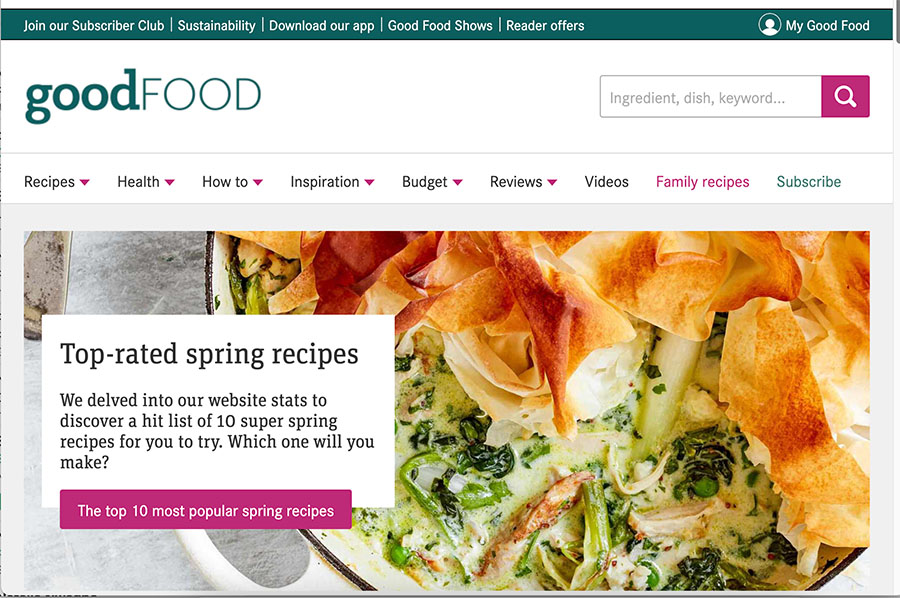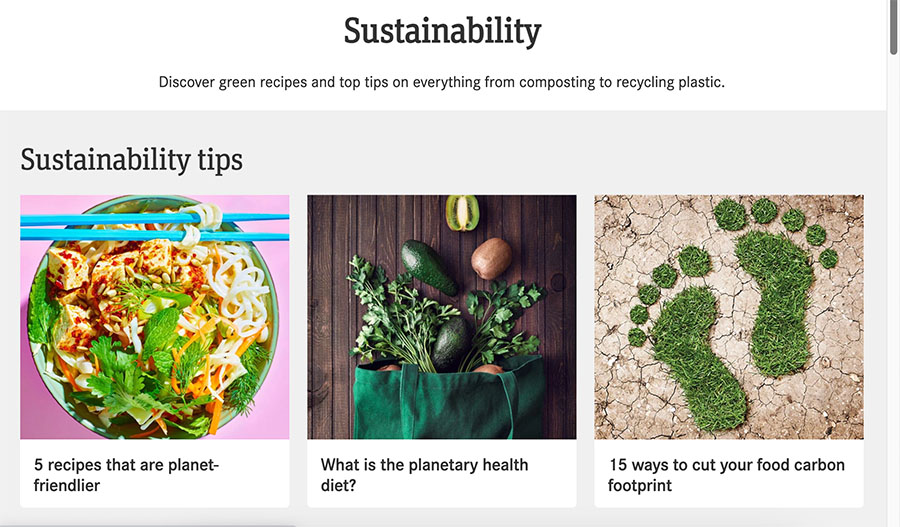In an era where everything is digital, the environmental impact of websites often goes unnoticed. However, for the team at Immediate, digital sustainability has become a central focus in their web design and development process. Recently, they embarked on a journey to understand and mitigate the carbon footprint of the biggest website in their portfolio, Good Food.
Wholegrain Digital’s Technical Lead, Tommy Ferry, and Digital Sustainability Lead, Marketa Benisek, sat down with Michelle Whitehead, Sustainability Lead at Immediate , Linzi Ricketts, Senior Product Manager and Filippa Furniss, Product Manager, and Graham Martin, Solutions Architect, to delve into their perceptions of sustainable web design, their experiences implementing changes following Wholegrain’s a Sustainable Web Design Masterclass, and their ongoing efforts to reduce environmental impact while maintaining an engaging online presence.
Join us as we uncover the value of sustainability-first design thinking in the digital landscape.

Embarking on the digital sustainability journey
Firstly, let’s talk about your experiences and insights regarding the journey toward creating a more sustainable website for Good Food. Before the Sustainable Web Design Masterclass, how did you and your team perceive the concept of sustainable web design? Were sustainability considerations already part of your development and design process? If so, could you name some?
“Sustainability is definitely a topic we thought about within our processes prior to the Masterclass, but we weren’t 100% certain on what areas we could have a positive impact on as a tech department. There were lots we were already doing, especially when considering different technologies and services, however there was never anyone championing it within the department. We wanted to change that, which is why we set out creating a Product and Tech sustainability working group, looking at not only what we currently do, but what more we could do towards sustainability in tech.”
What were your initial reactions when presented with the findings from the website carbon audit? Were there any surprises or concerns that stood out to you?
“It was very interesting to hear the effect the site was having in terms of annual energy consumption and annual carbon emissions. It was really interesting to understand this visually, which meant we had a better sense of the size and impact our sites were having.”
Can you share some insights into the process of implementing the changes recommended in the Masterclass to make the Good Food website more sustainable? Were there any challenges or unexpected obstacles you encountered along the way?
“We went through all the recommendations with our Solutions Architect and stack ranked them based on estimated effort and performance benefit, alongside other changes that we wanted to make. One of the key challenges was ensuring buy-in from the leadership team and the wider business as to why prioritising sustainability work was important. We found emphasising the benefits of performance improvements from both a sustainability perspective and a revenue perspective really helped get people on board.”
From your experience with the Sustainable Web Design Masterclass and the subsequent changes made to the website, what would you say is the most valuable lesson you and your team have learned about integrating sustainability into web design and development practices?
“The Masterclass helped us to visualise everything. It made it very clear how much integrating sustainability into our processes could help reduce emissions and energy use, even from the most simple changes. A big take away was that we should include sustainability considerations from the beginning of any project, to save us time and effort revisiting previous work to make improvements. Seeing the results from the first change has encouraged us to continue to push for more ambitious sustainability targets.”
CO2 savings
Given the sheer scale of the Good Food website, with tens of thousands of URLs, Immediate made a strategic decision to focus their efforts on auditing the first 30,000 URLs, which represent the majority of site traffic. After Immediate made some changes to the Good Food website, the team at Wholegrain Digital analysed data from approximately 3,000 URLs, which cover approximately 75% of page views, to find out how much data and carbon emissions were saved as a result of these changes. The results were fascinating.
The calculations revealed that the optimisations could have led to a remarkable reduction in page sizes, approximately 766 MB in total. This reduction then translates to an estimated annual data transfer reduction of a staggering 197,147 GB, resulting in approximately 29,063 kg of CO2 emissions saved on a standard grid.
These numbers highlight the significant impact of sustainability-focused web design efforts. It also serves as a testament to the power of collaboration and innovation in driving positive change. As we continue to navigate the complexities of digital sustainability, initiatives like this set a great example for the industry, inspiring others to follow in their pursuit of a more sustainable future.

It’s fascinating to learn about the estimated carbon savings resulting from the video optimisations made to the Good Food website (approximately 29,063 kg of CO2e with more changes to come later this year!). Can you walk us through the changes implemented by your team so far to achieve these reductions in page size and data transfer?
“One of the key changes we have implemented so far is around video facades. Previously we would automatically load video embeds, and we have a lot of content on our site that includes video so this was adding huge weight to the page. We now display an image as a video thumbnail, then once clicked on by the user, the video then loads.”
Were there any aspects of the sustainability-focused changes that you or your team found particularly challenging or imperfect? How did you navigate through these challenges?
“One of the challenges is that we have a huge amount of legacy content going back decades, which is incredibly difficult to improve at scale. Due to the nature of our website and how much is written every day by our content creators, a key aim is to thoroughly educate our editors on best practice around things like image formatting, limiting the number of unnecessary images , and length of content. This will ensure that as we produce new content, we’re adhering to sustainable best practice.”
How have you found balancing business objectives against sustainability? Have they worked well together or has your team had to make any trade-offs?
“We recently introduced a sustainability section to any work submitted for development, so we can understand the sustainability benefit or risk on each business objective. As mentioned previously, the challenge is balancing sustainability improvements with potential revenue impacts. However, we’ve found there is often a happy medium, where improved sustainability often leads to higher performance. This can be translated to faster page load, or a shorter time to first ad, which all contribute to an increase in revenue. We’ve found that emphasising these points with the wider business means we are more likely to get the leadership support required to get our proposals onto our roadmap.”
Reflecting on the changes made to reduce the website’s carbon footprint, do you feel that the effort was worth it? Have you noticed any significant improvements in sustainability metrics since implementing these changes?
“Using our performance monitoring tools, we’ve been able to track real-world improvements following our sustainability improvements. We’ve worked to reduce some of the JavaScript required on our web pages including using video facades to ensure we only load this JavaScript when it’s needed. This helps to reduce the volume of data we need to transfer for each user and reduces the processor and battery power required to run pages on a user’s device. Since launching video facades we’ve seen improvements of up to 25% to Interaction to Next Paint (INP), one of Google’s Core Web Vital metrics that is heavily influenced by the amount of JavaScript running on a page. This also helps to drive improvements to key metrics like search engine ranking and our ad speeds, helping to demonstrate the business value in delivering sustainability improvements.”
As you continue to explore ways to further reduce the environmental impact of the Good Food website, what areas do you see as having the most potential for additional improvements? Are there any new technologies or approaches you’re considering integrating into your sustainability efforts?
“We’ll endeavour to continue monitoring our sustainability, working towards implementing all the relevant changes and improvements outlined in the masterclass feedback whilst continuing to explore further improvements we can make.
A site like Good Food is always evolving and is operating at a scale where seemingly small improvements can ultimately lead to significant reductions in our environmental footprint. We’ll be continuing to embed a sustainability perspective into our workflows to ensure we are always seeking these opportunities. Some of our biggest step-changes are likely to come from personalisation and intelligent decision making with an aim of optimising our pages for individual users showing them more focused, relevant content, functionality and advertising enabling us to reduce the overall size of our pages.”
Looking ahead, do you foresee any challenges or opportunities in maintaining these sustainability gains as the Good Food website continues to evolve and grow? How do you plan to sustain and build upon these achievements in the long term?
What started as an interest in how we could try to make our sites more sustainable has in the last six months evolved into a well-established Product and Tech Sustainability working group. Members of this group represent the department in the wider business sustainability panel, known as the Changemakers. There we work together with representatives from across the entire business to champion sustainable practices, educate our colleagues on changes they can make both at work and at home, and organise events to promote climate action.
About Immediate
Immediate is committed to being a sustainable media company by reducing the impact we have on the environment and helping to drive understanding and change through the content we create. Our goal is clear: by 2030, we aim to cut greenhouse gas emissions from our business and supply chain by 30%, working towards achieving net zero by 2045. Over the last couple of years we have been working hard to reduce the emissions of our supply chain. It is clear that as our business grows its digital output, we need to be mindful of our digital emissions, so working with Wholegrain Digital has been incredibly insightful. The audit of the Good Food Website and accompanying masterclass was a really galvanising piece of work that brought the product and tech teams and digital content creators together and helped to give them a clear plan of action to ensure that our websites are as sustainable as they can be.

